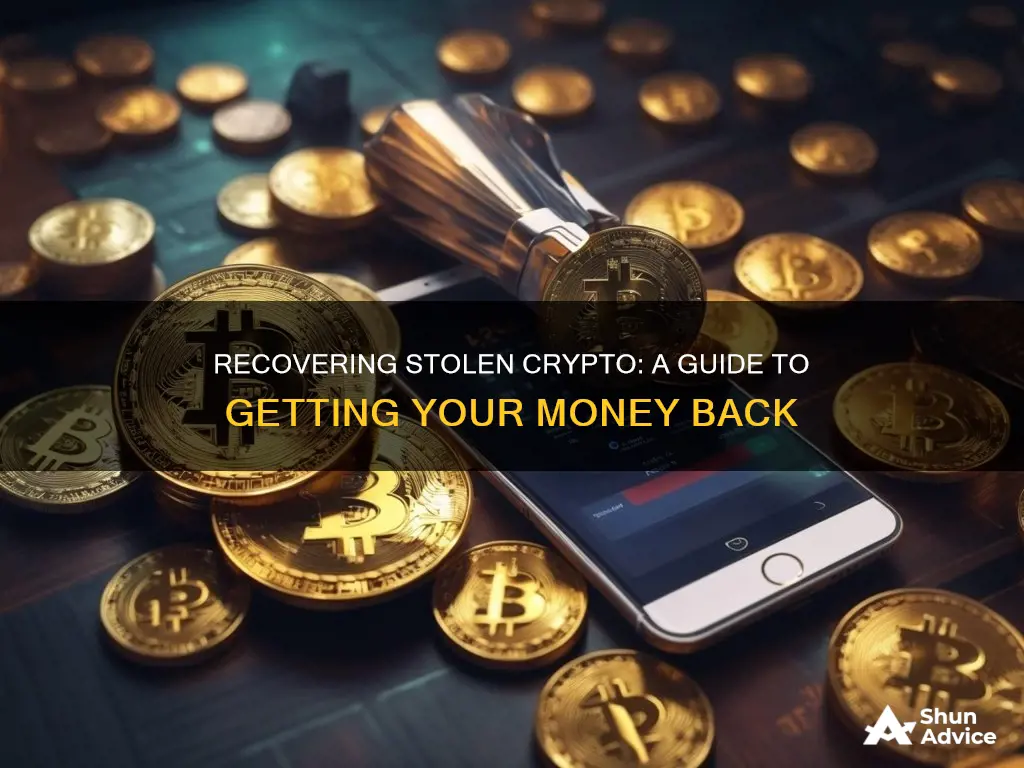
Recovering stolen cryptocurrency is a complex and challenging process due to the anonymous and decentralised nature of blockchain technology. However, immediate and strategic action can increase the chances of regaining lost digital assets. Here are the key steps to take:
- Contact your crypto wallet provider and relevant cryptocurrency exchanges to notify them of the theft and request their assistance in monitoring and flagging any suspicious activities.
- Report the incident to law enforcement agencies, including local police and cybercrime units, to initiate a formal investigation. Provide detailed information such as transaction IDs, wallet addresses, timestamps, and related correspondence.
- Seek professional help from companies specialising in digital asset recovery, who can employ blockchain analysis tools to track the movement of your stolen funds.
- Enhance the security of your remaining assets by changing passwords and enabling two-factor authentication on all related accounts to prevent further losses.
- Engage with the cryptocurrency community through forums and social media to raise awareness about the theft and seek support and advice from other users.
| Characteristics | Values |
|---|---|
| First steps | Act fast and secure remaining assets, e.g. by changing passwords and enabling two-factor authentication. |
| Reporting | Notify authorities, wallet providers, and exchanges with transaction details. |
| Professional help | Seek expertise, especially for complex cases. |
| Legal options | Consult specialised lawyers. |
| Tracking | Use blockchain forensics tools and community-led efforts. |
| Prevention | Use hardware wallets, enable two-factor authentication, keep software updated, and be vigilant against phishing. |
What You'll Learn

Report to wallet provider and exchanges
Immediately inform your crypto wallet provider about the theft. Provide any transaction IDs or wallet addresses involved and ask for any recent activities that could trace the thief.
Notify all relevant cryptocurrency exchanges where the stolen cryptocurrency might be traded. Contact all exchanges where you have accounts and provide them with the details of the theft. Request that they track and flag any suspicious activity linked to your stolen assets. Exchanges can support the recovery process by aiding investigators in offering relevant transaction information and freezing the involved accounts.
It is important to act swiftly and report the incident to the relevant exchanges. This not only helps protect other users but also increases the chances of recovering your funds.
Ondo Coin: A Worthy Investment?
You may want to see also

Alert law enforcement
Alerting law enforcement is a crucial step in recovering stolen cryptocurrency. Here are some detailed instructions to guide you through this process:
- Gather Evidence and Information: Before contacting law enforcement, ensure you have all the relevant information and evidence pertaining to the theft. This includes transaction details, timestamps, wallet addresses, and any other pertinent details. Take screenshots, preserve digital traces, and create a chronological record of events to present a comprehensive report to the authorities.
- Report to Local Law Enforcement: Contact your local police department and provide them with the evidence and information you have gathered. They will guide you through the process of filing a report and initiating an investigation. Remember to keep a copy of the report for your records.
- Reach Out to Cybercrime Units: In addition to local police, get in touch with specialized cybercrime units or agencies that specifically deal with online scams and cybercrimes. These units often have the necessary expertise and resources to effectively investigate and address cryptocurrency-related crimes.
- Provide Necessary Details: When reporting the theft, ensure you provide your personal details, transaction IDs, wallet addresses, timestamps, and any relevant correspondence. This information is crucial for law enforcement to initiate their investigation and take appropriate legal actions.
- International Cooperation: If the theft involves multiple jurisdictions or international parties, don't hesitate to seek assistance from international law enforcement agencies. The FBI, for example, can coordinate with international agencies in cases of large-scale thefts. This broadens the scope of the investigation and increases the chances of recovering your funds.
- Be Persistent: Law enforcement agencies may have varying levels of expertise and interest in cryptocurrency-related crimes. If you encounter a lack of cooperation or understanding, be persistent and seek assistance from other agencies or consider hiring a lawyer specializing in this field. Remember, your chances of recovering your funds increase with swift and decisive action.
Ape Coin: Worthy Investment or Just Hype?
You may want to see also

Document the incident
Documenting the incident is a crucial step in the process of recovering stolen cryptocurrency. Here are some detailed instructions on how to effectively document the incident:
- Capture relevant information: Take screenshots or records of all communications, transactions, and any other evidence related to the scam. Ensure you have records of transaction IDs, wallet addresses, timestamps, and correspondence related to the incident. This documentation will serve as proof when reporting the scam to authorities and exchanges.
- Preserve digital evidence: In addition to the screenshots and records, ensure you preserve any digital traces of the scam, such as email headers, IP addresses, and website URLs. This information can be crucial for law enforcement agencies and investigators to trace the perpetrators and analyse their methods.
- Maintain a chronological record: Create a detailed timeline of events, including dates, times, and descriptions of each interaction with the scammer. This chronological account will provide a comprehensive overview of the incident when reporting it to authorities and investigators. It will also help you recall specific details that may be important for the investigation.
- Secure relevant accounts: Ensure that you secure the accounts and devices associated with the incident. Change passwords and enable two-factor authentication to prevent further unauthorised access. This will also demonstrate to investigators that you have taken the necessary steps to protect your accounts and devices.
- Report to cryptocurrency exchanges: If the scam involved a specific cryptocurrency exchange, be sure to report the incident to their support team. Provide them with all the relevant information and evidence you have gathered. They may be able to trace the transactions, identify suspicious activities, and potentially freeze the accounts involved.
- Contact wallet providers: Immediately inform your crypto wallet providers about the theft. They may have protocols in place to monitor and halt any unauthorised transactions. Provide them with transaction IDs, wallet addresses, and any other relevant information.
Bitcoin: My Reasons for Not Investing
You may want to see also

Contact custodial services
Crypto custodians are third parties that can be hired to look after your cryptocurrency investments. They act as safeguards of your money and are essential for the widespread adoption of digital assets. Crypto custodians are registered, regulated financial institutions that have acquired a state-level or national license to act as a custodian.
Crypto custodians hold clients' private keys to their wallets in a safe manner and ensure the security of their holdings. This is done by storing the private keys in cold wallets, which are kept offline and protected by security measures such as encryption and multi-signature requirements. These cold wallets are often held in secure locations such as vaults or bunkers, with additional security measures such as biometric access control and 24/7 surveillance.
When choosing a crypto custodian, it is important to consider their security measures, insurance protection, and reputation. It is also worth noting that custodians may charge a certain percentage point based on the value of the assets under custody every year, as well as a flat rate for opening a custodial account.
- Anchorage
- NYDIG
- Paxos
- BNY Mellon
- Citibank
- Fidelity
- BitGo
- Bakkt
- Coinbase Trust
The Future of Bitcoin: Should You Invest?
You may want to see also

Secure remaining assets
The first step to securing your remaining assets is to change your passwords and enable two-factor authentication on all your related accounts. This will ensure that the scammer cannot access your accounts and cause further damage.
It is also important to monitor your accounts and the blockchain for any movement of your stolen cryptocurrency. You can use blockchain explorers to keep track of the movements of your stolen funds. Additionally, set up alerts for any activity related to your digital assets.
You should also report the theft to your local and national law enforcement agencies. Provide them with all the relevant details to aid in their investigation. Keep consistent follow-ups for any updates on your case.
Furthermore, notify your wallet provider and cryptocurrency exchanges about the theft. Inform them of the details of the theft and request them to flag and monitor for any suspicious activity linked to your stolen assets.
Lastly, consider hiring a crypto recovery service to help you navigate legal processes and explore potential avenues for fund recovery. These professionals are skilled in dealing with such situations and can guide you through the complex world of crypto scam recovery.
Dogecoin Investment: Is It Worth Your Money?
You may want to see also
Frequently asked questions
Act fast! Time is critical in recovering funds. You should secure your remaining assets by changing all passwords and enabling two-factor authentication. Contact your wallet provider and any relevant cryptocurrency exchanges to flag the stolen funds. Report the theft to law enforcement and provide all relevant details, including transaction IDs, wallet addresses, and timestamps.
The chances of recovery depend on various factors, including the speed of response, the type of theft, and the level of cooperation from authorities and exchanges. While not all cases guarantee a full recovery, success stories do exist, and swift action significantly improves the likelihood of reclaiming your funds.
To protect your cryptocurrency from theft, it is recommended to use hardware wallets, enable two-factor authentication, and regularly update your software and security protocols. Be vigilant against phishing attempts and always verify the legitimacy of platforms before sharing sensitive information.
Common types of cryptocurrency scams include Ponzi schemes, phishing scams, fake exchanges and wallets, initial coin offering (ICO) fraud, and pump and dump schemes. Scammers often use fake investment platforms, send fraudulent emails, or promise high returns to trick users into revealing their private keys or login credentials.
In addition to the immediate steps mentioned in the first answer, you can consider seeking professional help from crypto recovery services or lawyers specializing in cryptocurrency scams. You can also reach out to the crypto community for support and raise awareness to prevent others from falling victim to similar scams. It is important to act quickly and provide thorough documentation of the theft, including all relevant transaction details and communications.







